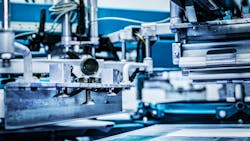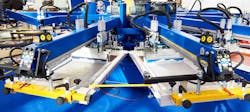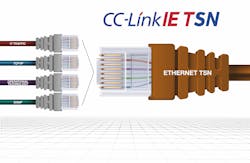Advancing Motion Control in Industrial Printing Machines with TSN
Developers of printing machines are facing particularly fast-paced and dynamic market conditions. Harnessing the true potential of smart, automated industrial operations is crucial to meeting ever more ambitious customer needs while also staying ahead of the competition. As fractions of a second can make a significant difference within advanced printing machines, cutting-edge motion control becomes paramount.
Time Sensitive Networking (TSN) offers OEMs and their customers a way to help achieve seamless synchronization, accuracy, and precision within complex, autonomous printing systems.
Industry Drivers for Improved Networking
In many sectors, from publishing to pharmaceutical manufacturing, printing and stamping operations rely on machines that can quickly and reliably add high-quality designs and text with excellent resolution. To this end, the equipment must effectively offer precise positioning capabilities, correctly handle products and have all its axes moving in sync.
State-of-the-art motion control is therefore at the core of such units and their activities. Even more, as printing applications demand higher speed, greater resolutions and accuracies as well as lower tolerances, the need for next-level motion control solutions is evident.
As Industry 4.0 frameworks become a must to remain competitive, printing machine users are asking for solutions that can communicate with other machines on the shop floor as well as higher enterprise-level systems to support smarter operations.
Ultimately, to meet these demands, OEMs need to create highly interoperable setups that are equipped to offer this level of convergence. In this regard, the selected industrial automation components must be able to leverage a high-performance network technology.
How TSN Can Address Motion Control Needs of Industrial Printing
Traditionally, standard Ethernet has had limitations in meeting the stringent requirements of motion control, necessitating the setup of isolated networks to reduce latency, avoiding jitter and delay. The advent of TSN is providing a breakthrough solution. This technology, defined by IEEE 802.1 standards, is capable of establishing accurate, distributed time synchronization across multiple axes and network nodes.
TSN also enables the prioritization of urgent, time-sensitive traffic, while reserving cycle time for regular control data packets. This ensures deterministic performance even with large volumes of non-transient traffic, eliminating the need for specialized communication infrastructures for motion control. As a result, TSN can support the seamless integration of various message types from both the information technology (IT) and operational technology (OT) domains, in line with smart manufacturing strategies.
A leading network solution that embraces this technology is CC-Link IE TSN, the first open industrial Ethernet with TSN functions and gigabit bandwidth. It offers a cycle time of 31.25µs and can synchronize up to 256 axes with accuracies in the order of ±1µs, therefore helping machine builders and end users with ambitious motion control systems for printing applications.
Case Study: TSN Helps OEM Advance Machine Capabilities
A leading OEM of industrial printing and stamping machines wanted to develop an innovative, highly competitive solution to address its customers’ needs for increased speed, accuracy and repeatable quality. To deliver such a machine, the company invested in industrial automation technologies compatible with CC-Link IE TSN, namely PLCs and servo drives.
READ MORE: “Making Automation Easy Starts With the Design Process”
In particular, the resulting machine could combine high-precision screen printing and hot stamping operations by being able to accommodate 90 axes. Through CC-Link IE TSN, these could all be synchronized with limited tolerances to deliver the high level of accuracy that customers would require.
As a result, the setup offers a highly integrated and versatile solution that maximizes productivity, cost-effectiveness, flexibility, print quality as well as scalability.
Extremely happy with the capabilities of CC-Link IE TSN compatible devices, the OEM is now using them to upgrade its printing machine portfolio, driving its customers as well as its own competitiveness.
This article was written and contributed by Thomas J. Burke, Global Strategic Advisor for the CC Link Partner Association (CLPA), which aims to provide collaboration on industrial network connectivity worldwide. In addition, he serves as Global Director of Industry Standards for Mitsubishi Electric to lead the strategic development and adoption of networking standards, including the adoption of Mitsubishi Electric’s open networks solutions.
About the Author
Thomas J. Burke
Global Strategic Advisor for the CC Link Partner Association (CLPA)
Thomas J. Burke is Global Strategic Advisor for the CC Link Partner Association (CLPA) which aims to provide collaboration on industrial network connectivity worldwide.
In addition, Tom serves as Global Director of Industry Standards for Mitsubishi Electric to lead the strategic development and adoption of networking standards, including the adoption of Mitsubishi Electric’s open networks solutions. Tom is also the Global Directory of Industry Partnerships for ICONICS, providing leadership to increase market share of ICONICS’ leading-edge product portfolio.
Tom’s background includes being the former OPC Foundation President & Executive Director and pioneered the OPC Unified Architecture (OPC UA) as the foundation of information integration and interoperability.
He has a bachelor’s degree in theoretical mathematics from John Carroll University (Cleveland, OH), and a master’s degree in computer engineering from the University of Dayton (Dayton, OH).

Leaders relevant to this article:


